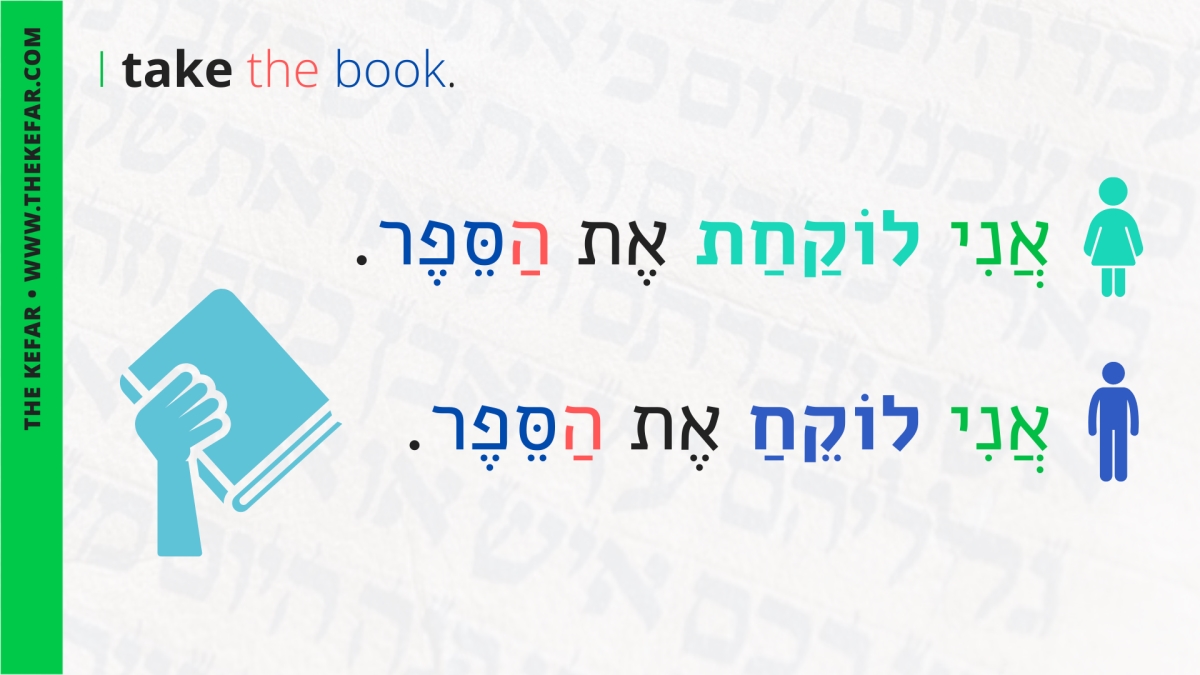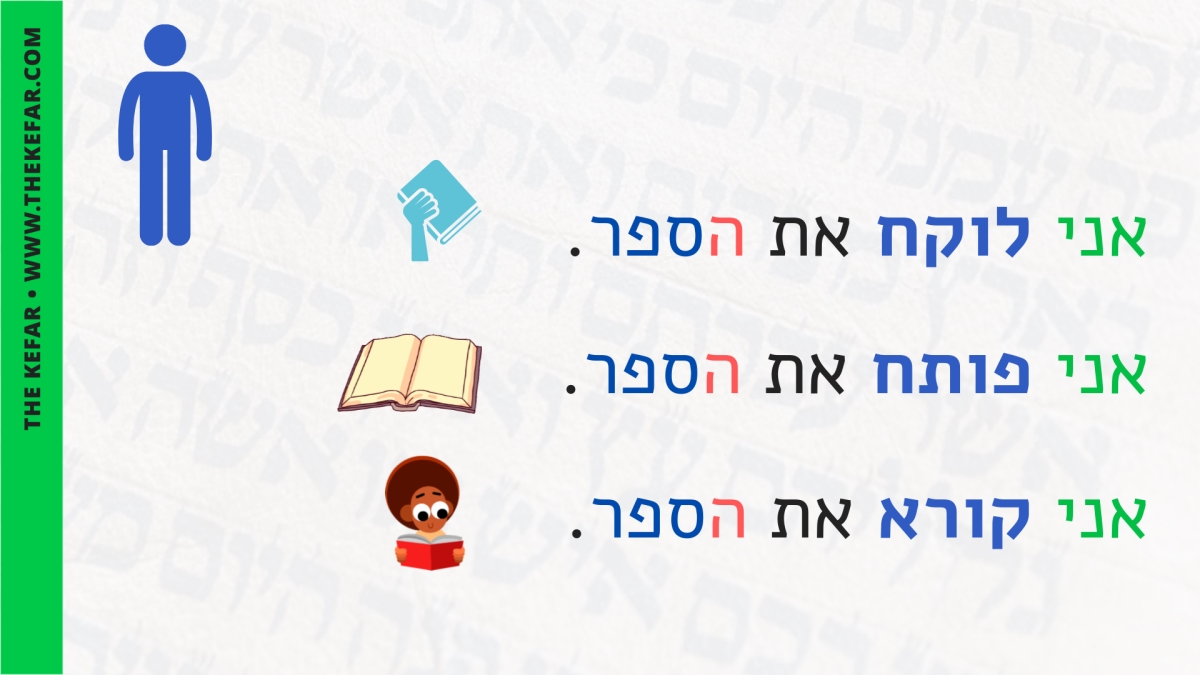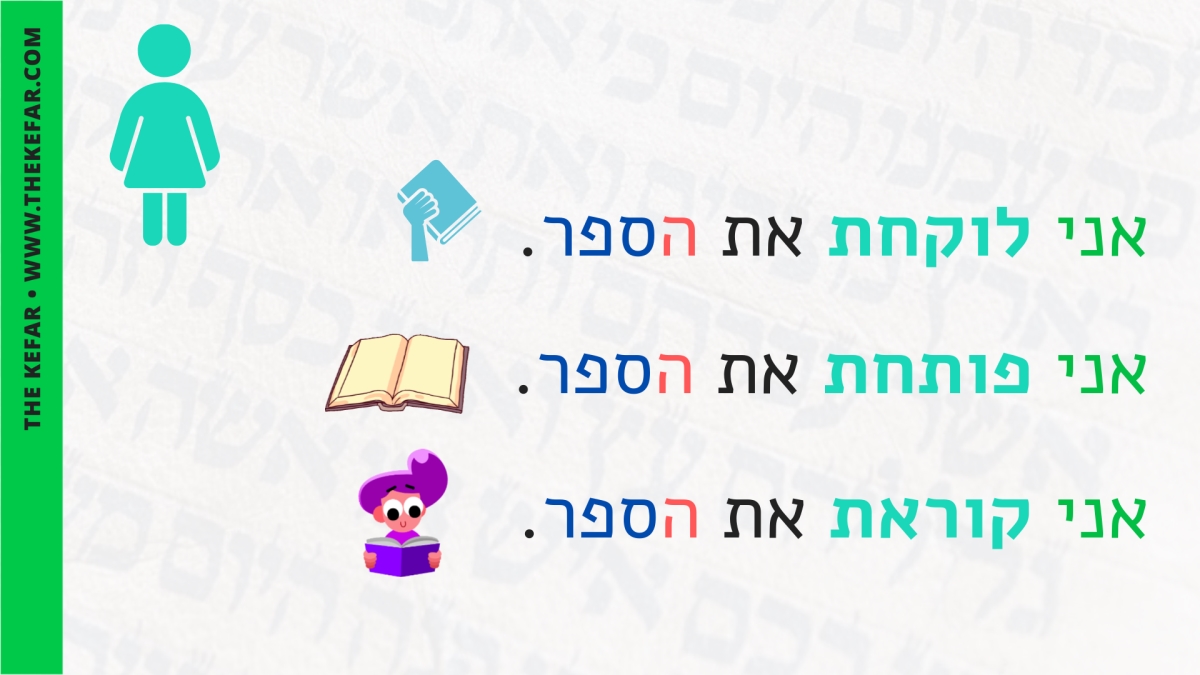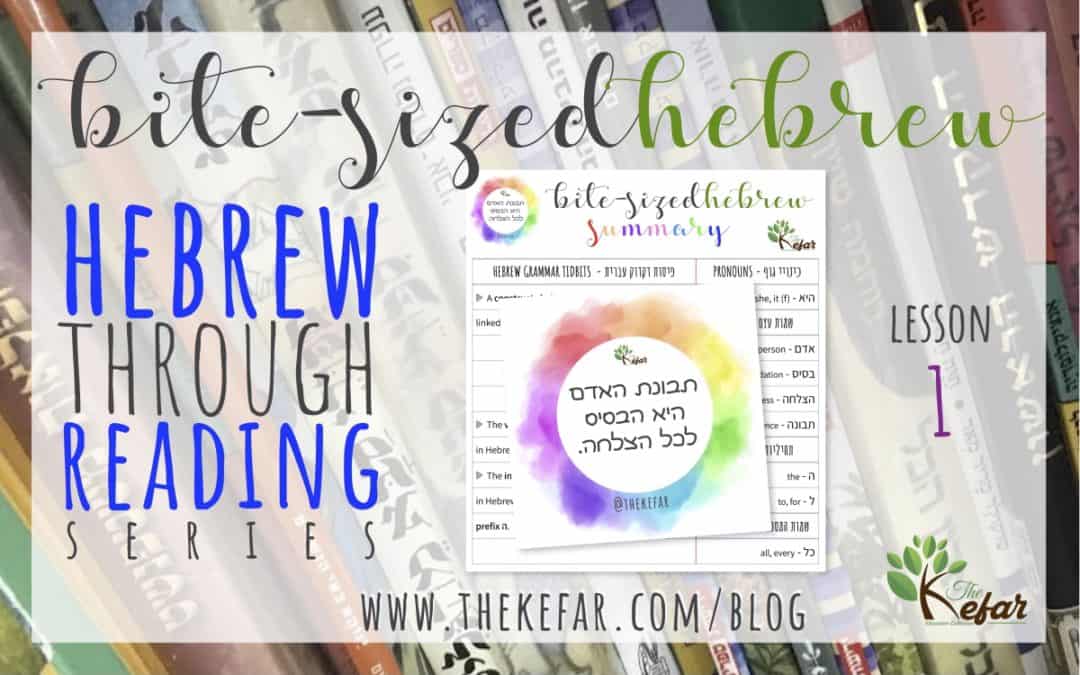A few weeks ago, I launched a daily everyday Hebrew Sentence Series on YouTube to help you learn everyday Hebrew, one sentence at a time. Each week, we focus on a particular action, like reading a book, wearing a mask, or making a PBJ sandwich, and break down that action into four or five steps. We learn one step (one step = one sentence) a day, and on the last day of the week, we put all of the Hebrew sentences together and review the entire sequence.

The sentences are color coded to help you implicitly learn Hebrew sentence structure and grammar, and it matches with the English so you’re clear on what each sentence means. All new Hebrew words are introduced with nikkud ניקוד (Hebrew vowels), and then as they appear in future sentences, the nikkud ניקוד is removed. This will help you get better at recognizing and reading Hebrew words without vowels.

The Hebrew sentences are also provided in both the masculine and feminine forms, so that you are able to learn and practice speaking using both.

The goal of the daily everyday Hebrew sentence videos is for you to learn Hebrew within the context of things that you do regularly. As your vocabulary grows, you can switch up the nouns, adjectives, and adverbs with the verbs that you learn, and really expand the number of things that you’re able to say in Hebrew.
After every few videos, I’ll publish a blog post like this that gives you some additional information on Hebrew verbs, grammar, etc., related to the sentences you’ve learned. I’ll also give you some practice exercises and bonus vocabulary to help reinforce your Hebrew learning. BO’U NATCHIL בואו נתחיל – let’s get started!
Hebrew Verb Notes
🔵 You’ve learned six verbs from the first three everyday Hebrew sentence series: take, open, read, close, write, and put back/return. You’ve learned how to use these verbs in the present tense, in both their singular masculine and feminine forms.
🟢 Verbs in Hebrew must always match the subject. So if David is reading, we have to use the masculine singular KORE קורא. If Tamar is reading, we have to use the feminine singular KORET קוראת.
🔵 The verbs SOGER סוגר and KOTEV כותב, and SOGERET סוגרת and KOTEVET כותבת conjugate in the same ways. This is the most basic Hebrew conjugation form. If you want to learn more about verbs like these, watch this video.
🟢 The verbs POTEACH פותח and LOKEACH לוקח, and POTACHAT פותחת and LOKACHAT לוקחת conjugate in the same ways (listen to how the vowels are exactly the same for the masculine, and exactly the same for the feminine). This is because they are both simple Hebrew verbs that end in the letter CHET ח. If you want to learn more about verbs like these, watch this video.
🔵 When you watch future Hebrew sentence videos, pay attention to the verb sound patterns, and see which ones sound like verbs you already know.
Hebrew Verbs Exercise
In this exercise below, match each Hebrew verb to the correct sentence, based on the subject.
Hebrew Adjective Notes
🔵 You’ve learned two adjectives from the first three everyday Hebrew sentence series: closed, and empty.
🟢 Adjectives in Hebrew come after nouns, so it’s the opposite of what we do in English. A “closed book” would be “book closed” in Hebrew – SEFER SAGUR ספר סגור.
🔵 Hebrew adjectives must also match the gender of the noun. Masculine nouns are described with masculine adjectives, and feminine nouns are described with feminine adjectives.
🟢 Adjectives often share roots with related verbs. Did you notice that SOGER סוגר sounds kind of like SAGUR סגור? They’re both related to closing, and they share the same three root letters – SAMECH ס, GIMEL ג, and RESH ר. To learn more about Hebrew roots, check out this playlist.
🔵 Feminine adjectives in Hebrew often end in -AH. Pay attention to adjectives in future videos, and see if you can determine whether they are masculine or feminine. That will also help you identify whether the noun it’s describing is masculine or feminine, since the genders always have to match.
Exercise 2: Review Adjectives
In this exercise below, you’re going to discover the feminine forms of the masculine Hebrew adjectives you learned, and use them to describe nouns. If you read the information above on Hebrew adjectives, this exercise will be easy peasy lemon squeezy!
Additional Hebrew Grammar Notes
🔵 The Hebrew preposition ET את doesn’t have a translation into English. It’s used with some verbs when the noun that follows is definite (i.e. the ___). If the noun is indefinite (i.e. a ___, an ___), then ET את is not used. For example, “he takes the book” is HU LOKEACH ET HASEFER הוא לוקח את הספר, but “he takes a book” is HU LOKEACH SEFER הוא לוקח ספר. To learn more about ET, read this blog post, and/or watch this video.
🟢 Adverbs in Hebrew are often created by adding the letter BET ב to nouns. For example, SHEKET is quiet; B‘SHEKET becomes quietly.
Exercise 3: Hebrew Listening Comprehension
In this exercise, you will hear seven Hebrew sentences that use words from the first three everyday Hebrew sentence series (plus the two new feminine adjectives you learned from this post). Translate each Hebrew sentence into English.
DISCLAIMER: I could only input one correct option, even though you might be able to translate the sentence correctly in a number of ways. For example, הִיא מַחֲזִירָה אֶת הָעֵט could correctly be translated as: (1) She puts the pen back (2) She returns the pen (3) She puts back the pen (4) She is putting back the pen (5) She is putting the pen back or (6) She is returning the pen. If I put in option 1, but you typed in any of the other choices, the system will mark it as incorrect, but you go ahead and give yourself those points anyway!
To try and keep it simple, all of the answers are in the simple present (i.e. you write, I close).
Some Final Hebrew Notes
🔵 Hebrew just has one present tense form, so it’s used for both present simple (e.g. I read) and present progressive (e.g. I am reading).
🟢 Use the Hebrew word LO לא to negate verbs. For example, DAN KOTEV דן כותב = Dan is writing/Dan writes. DAN LO KOTEV דן לא כותב = Dan is not writing/Dan doesn’t write.
BONUS Hebrew Vocabulary
If you’d like to learn some extra Hebrew vocabulary, here are four bonus words (including LO לא) that are related to the vocabulary you’ve learned from the first three everyday Hebrew sentence sequences.
Make Hebrew sentences using these four new words, along with the verbs and other vocabulary you learned from the videos. Leave your sentences in the comments!
Zehu זהו – that’s all folks!
I hope you enjoyed these Hebrew exercises and found them helpful, and make sure you’re subscribed to my channel so you don’t miss a single sentence!
Until next time,


Bite-Sized Hebrew Lesson #1 { htr series }
I recently told you about the Hebrew reading strategies I use to increase my vocabulary,...


Thank you so much for sharing your knowledge in a practical way that truly facilitates learning and comprehension!